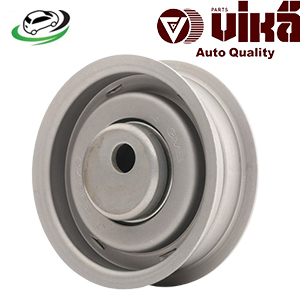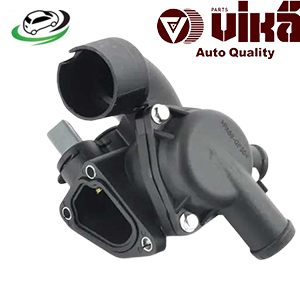-4%
Get VW Touareg V6 Base 3.2L 2004-2006 Thermostat Housing Assembly 022121111G
The thermostat housing assembly is an integral component of a vehicle’s cooling system. Its primary role is to house the thermostat and regulate the flow of coolant between the engine and the radiator. This assembly plays a crucial part in ensuring that the engine operates within its optimal temperature range, preventing overheating and maintaining efficient engine performance.
The thermostat housing serves as the conduit between the engine and the cooling system. It ensures that coolant only flows to the radiator when the engine reaches a specific temperature, helping maintain efficient engine operation. A faulty thermostat housing assembly can lead to major issues, such as overheating or engine inefficiency, making it an essential component to keep in good working condition.
2. Structure and Design of the Thermostat Housing Assembly
The thermostat housing assembly consists of several key components:
- Thermostat Housing: The thermostat housing is the outer casing that holds the thermostat. It is usually positioned near the engine’s cylinder head or intake manifold. Its primary function is to provide a secure, sealed environment for the thermostat, keeping it free from debris and external elements.
- Thermostat: The thermostat is a temperature-sensitive valve that controls the flow of coolant. It is designed to remain closed when the engine is cold, allowing the engine to warm up quickly. Once the engine reaches its optimal operating temperature (usually around 195°F or 90°C), the thermostat opens, allowing coolant to flow through the engine and into the radiator.
- Gasket or O-Ring: A gasket or O-ring seals the thermostat housing to the engine, preventing coolant leaks. This component ensures that the coolant remains contained within the system and doesn’t escape from the housing assembly.
- Hose Connections: The thermostat housing has inlets and outlets that connect to the engine’s cooling system, including hoses that direct coolant to the radiator and back into the engine. These connections are essential for controlling the flow of coolant.
The materials used for thermostat housing assemblies vary based on the vehicle and application:
- Plastic: Many modern cars use plastic thermostat housings due to their lightweight and cost-effectiveness. Plastic can handle moderate temperatures and pressure but can be prone to cracking or warping over time.
- Aluminum: Higher-end and performance vehicles often use aluminum thermostat housings for their superior durability and heat resistance. Aluminum can withstand higher temperatures and is less likely to crack or warp compared to plastic.
3. How the Thermostat Housing Assembly Works
The thermostat housing assembly is designed to regulate the flow of coolant based on the engine’s temperature. Here’s a step-by-step explanation of how it works:
- Cold Engine Start: When the engine is first started and is still cold, the thermostat remains closed. This prevents coolant from circulating through the radiator, allowing the engine to reach its optimal operating temperature more quickly. During this phase, the coolant stays inside the engine, absorbing heat.
- Engine Warms Up: As the engine runs, it generates heat. Once the coolant temperature rises to the thermostat’s threshold (usually between 180°F and 200°F), the thermostat begins to open gradually.
- Coolant Flow to the Radiator: When the thermostat opens, it allows coolant to flow from the engine into the radiator. The radiator is designed to cool the hot coolant by dissipating heat to the surrounding air. The coolant then returns to the engine at a lower temperature, repeating the cycle.
- Thermostat Closing: If the engine temperature drops below the thermostat’s set point, the thermostat will close again, preventing coolant from flowing to the radiator. This helps the engine maintain a stable operating temperature.
The thermostat housing assembly is critical in this process as it ensures the proper flow of coolant at the right times, protecting the engine from overheating and preventing temperature fluctuations that could damage engine components.
4. Importance of the Thermostat Housing Assembly
The thermostat housing assembly plays a vital role in maintaining engine efficiency and longevity. Here’s why it’s so important:
- Regulates Engine Temperature: By controlling the flow of coolant, the thermostat housing assembly ensures that the engine operates within its optimal temperature range. This prevents both overheating and underheating, which can lead to performance issues, engine damage, or even failure.
- Improves Fuel Efficiency: When an engine runs at its ideal temperature, fuel combustion is more efficient. A malfunctioning thermostat housing assembly can cause the engine to run too hot or too cold, leading to increased fuel consumption and reduced efficiency.
- Prevents Overheating: If the thermostat or its housing assembly fails, it can lead to a stuck thermostat. A stuck closed thermostat can prevent coolant from reaching the radiator, causing the engine to overheat. This can lead to catastrophic engine damage, including warped cylinder heads or even complete engine failure.
- Reduces Engine Wear and Tear: Operating at a stable temperature minimizes the thermal expansion and contraction of engine parts, reducing wear and tear over time. A well-functioning thermostat housing assembly helps prolong engine life by keeping temperature fluctuations under control.
5. Common Issues with Thermostat Housing Assemblies
Despite their importance, thermostat housing assemblies can encounter various issues over time, particularly as the vehicle ages:
- Cracked or Warped Housing: Plastic thermostat housings are prone to cracking or warping due to constant exposure to high temperatures and pressure. Once the housing is damaged, coolant can leak, leading to engine overheating.
- Thermostat Failure: The thermostat itself can fail by either getting stuck in the open or closed position. If the thermostat gets stuck open, coolant will flow continuously, preventing the engine from reaching its optimal operating temperature. This can result in poor fuel efficiency and increased emissions. If the thermostat gets stuck closed, coolant won’t flow to the radiator, causing the engine to overheat.
- Coolant Leaks: Over time, the gasket or O-ring that seals the thermostat housing can wear out, allowing coolant to leak. Leaking coolant reduces the effectiveness of the cooling system, leading to overheating or low coolant levels.
- Corrosion: In older vehicles, the metal components of the thermostat housing can corrode due to prolonged exposure to coolant and moisture. Corroded housing can become brittle, leading to leaks or structural failure.
6. Maintaining the Thermostat Housing Assembly
Regular maintenance of the thermostat housing assembly can prevent many common issues and prolong the life of your engine’s cooling system. Here are some key maintenance tips:
- Monitor Coolant Levels: Regularly check the coolant levels in your vehicle’s radiator and overflow tank. Low coolant levels may indicate a leak in the thermostat housing or another part of the cooling system.
- Inspect for Leaks: Periodically inspect the thermostat housing and surrounding areas for any signs of coolant leaks, such as dried coolant residue or wet spots around the housing. Address any leaks immediately to prevent overheating.
- Replace the Thermostat When Necessary: If the thermostat fails, replace it promptly. Signs of a failing thermostat include engine overheating, inconsistent engine temperature readings, or a check engine light.
- Replace the Housing When Needed: If the thermostat housing shows signs of cracking, warping, or corrosion, it’s important to replace it before a failure occurs. Thermostat housings are relatively inexpensive, and replacing them early can prevent costly engine damage.
- Flush the Cooling System: Flushing the cooling system at regular intervals helps remove debris, rust, and old coolant that can affect the performance of the thermostat and housing. This also helps prevent corrosion inside the housing.
- Use the Right Coolant: Always use the manufacturer-recommended coolant type to ensure compatibility with your engine and thermostat housing. Using the wrong coolant can lead to corrosion or reduced cooling efficiency.
7. Replacing the Thermostat Housing Assembly
If your thermostat housing assembly is damaged or leaking, replacing it is relatively straightforward. Here’s a general overview of the replacement process:
- Drain the Coolant: Begin by draining the coolant from the radiator to prevent spills during the replacement process.
- Remove the Old Housing: Locate the thermostat housing, which is usually near the engine’s cylinder head or intake manifold. Remove the bolts securing the housing, and carefully detach the hoses connected to it. Be sure to collect any remaining coolant that leaks out.
- Replace the Thermostat: If the thermostat is housed within the assembly, replace it with a new one. Make sure to install it in the correct orientation.
- Install the New Housing: Install the new thermostat housing and gasket or O-ring. Tighten the bolts securely, but be careful not to overtighten, as this could crack the housing.
- Reconnect Hoses: Reattach the hoses to the new housing and secure them with hose clamps.
- Refill the Coolant: Refill the radiator and coolant reservoir with the appropriate type and amount of coolant. Be sure to bleed the cooling system to remove any trapped air, which could cause overheating.
- Test the System: Start the engine and allow it to reach operating temperature. Check for any leaks and ensure that the temperature gauge remains within the normal range.
8. Conclusion
The thermostat housing assembly is a vital component of a vehicle’s cooling system, responsible for housing the thermostat and regulating coolant flow between the engine and radiator. Proper function of the assembly is essential for maintaining the engine’s optimal operating temperature, improving fuel efficiency, and preventing overheating.
Regular maintenance, such as checking for leaks, replacing worn-out components, and using the right coolant, can help ensure that your thermostat housing assembly remains in good working order. By understanding the function, importance, and maintenance of the thermostat housing assembly, vehicle owners can prevent costly
Follow us on Facebook for more parts.




Reviews
Clear filtersThere are no reviews yet.